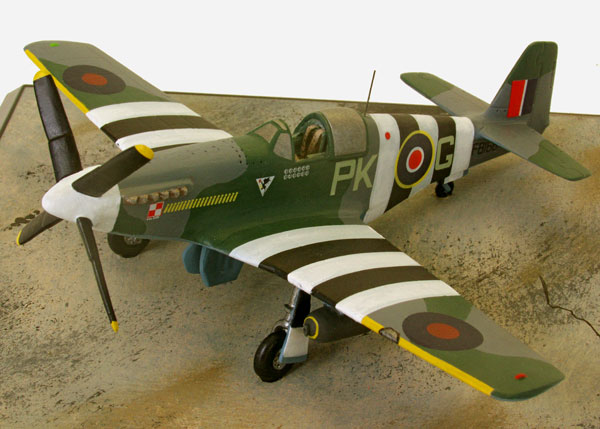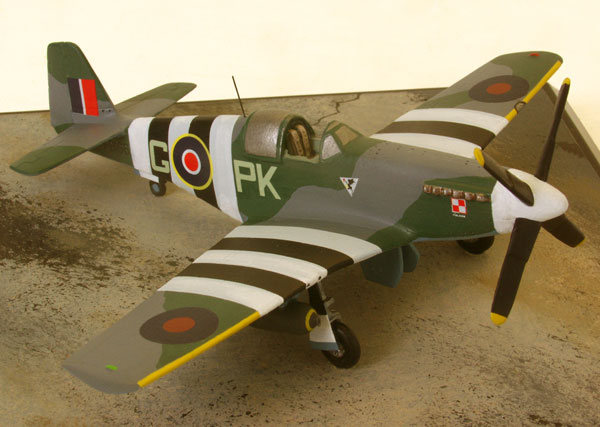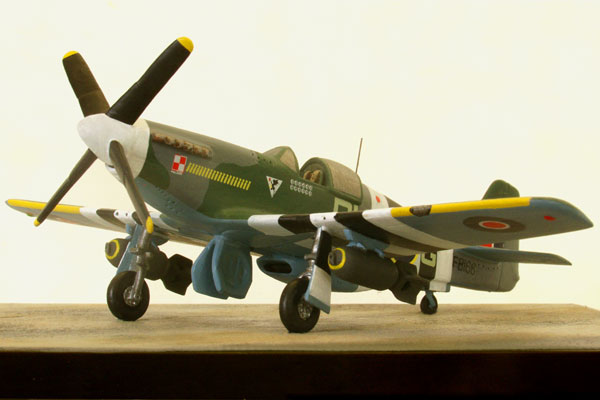North American Mustang Mk III
North American Mustang Mk III FB166 PK-G
315 Squadron, Sqn Ldr Eugeniusz ‘Dziubek’ Horbaczewski,
Brenzett, June1944.
The Mustang’s genesis was a response to the British Air Purchasing Commission’s request to North American Aviation in April 1940 to build the Curtiss P-40 under licence for the Royal Air Force; NAA countered with an offer to build an aircraft of their own design with a stipulation that the prototype should be completed within 120 days, and the first NA-73 rolled out of the assembly shed in 117. With the installation of the Allison engine delayed the aircraft first flew on 26 October 1940, by which time NAA had received a first order from Britain for 320; the US government required that two be evaluated by the Army Air Corps.
The Mustang I, fitted with an F.24 camera behind the pilot, entered service with No.2 Squadron, Army Cooperation Command at Sawbridgeworth in April 1942, and carried out its first operational sortie on 27 July; Mustangs photographed Dieppe before and during the Commando attack on the port in August 1942. The characteristics of the Allison V-1710 gave the Mustang a good low-level performance but this deteriorated with altitude, and the RAF received over 1500 aircraft, equipping nineteen squadrons, but it was the installation of the Rolls-Royce Merlin engine that enabled the design to fulfil its considerable potential. Four Mustangs, designated Mustang X, were modified by Rolls-Royce at Hucknall to take the British engine, testing various designs of radiator (though a proposal to fit the Merlin behind the pilot was not carried through). Following this orders were placed with NAA for over 2,000 of the re-engined variant; with the US designation P-51B the first flew in September 1942 and production, aircraft were delivered to the US Eighth Air Force in England in December 1943.
910 P-51B/Cs – they differed in their factory of origin – were delivered to the RAF, the first squadron to receive them being No.19 at Gravesend in February 1944. The RAF did not like the heavily-framed and close-fitting cockpit hood of the early marks, and a replacement bulged and frameless transparency, designed by R.Malcolm, was fitted to most Mustang IIIs (including FB166) and to many USAAF P-51Bs and Cs. With an increasing number of Polish pilots joining the Royal Air Force, 302 Squadron, the first of nine Polish squadrons within Fighter Command was formed at Leconfield in July 1940; No.315, the “Deblin” squadron, was formed with Hurricanes at Acklington in January 1941 and moved to Northolt, which had become strongly associated with the Polish squadrons, with Spitfires in July. It spent the occasional period away from the south-east, but was still in the London area at Heston when it received Mustang IIIs in April 1944. Following the invasion of Europe 315 Sqn. was at Holmesley South on the Hampshire coast in June, moving eastwards along the coast to Ford and then to Brenzett on the Romney Marshes where, although sometimes carrying out operations over Europe, its principal activity was anti-V1 patrolling.
Eugeniusz Horbaczewski was born in Kiev in 1917, but was brought up in Poland where in 1935 he received his “C” glider rating. He went to Officer Flying School in Deblin from which he emerged as Pilot, Second Lieutenant, graduating on 1 September 1939. He took no part in operations against the Luftwaffe, but left Poland with a large group of Polish aircrew on the 17th, travelling through Romania, Greece and France, where he is believed to have flown with a Polish flight at Bordeaux, before arriving in Britain in June 1940. Following RAF training he joined the Spitfire-equipped No.303 Polish Squadron at Northolt in October 1941, having his first encounter with the enemy on the 6th while escorting bombers over France. He was generally known to his Polish compatriot colleagues as “Dziubiek”, an informal equivalent of “Kid”. Horbaczewski’s first victory was recorded on 4 April 1942; while escorting a formation of Bostons he saw a Fw 190 attacking one of his Spitfire colleagues and shot it down, though sadly Lt. Daszewski, a Battle of Britain veteran, was lost. 303 Sqn. was involved in the Dieppe operation in August 1942 with Horbaczewski claiming his third kill, and at the end of the year he was posted to the “Polish Fighting Team”, a group of selected Polish pilots operating in North Africa under Wg.Cdr. Stanislaw Skalski and widely known as “Skalski’s Circus).
Posted to No.43 Squadron at Hal Far as a flight commander in July 1943 just before the invasion of Southern Europe, Horbaczewski became its CO on promotion to Squadron Leader a month later, the squadron was now in Sicily; by the time he was posted again in October he had added three more kills to his score. In February 1944 he became CO of 315 Squadron, their Spitfire Vcs being replaced by the Mustang III in the following month. Following the D-Day landings the squadron was engaged in a ground attack operation around Cherbourg on 22 June when one its Mustangs, flown by Lt. Tadeuz Tamowicz was damaged and forced down; his CO landed on a nearby airstrip that had just been built by the American forces, found Tamowicz and flew him back to base at Coolham. On anti-“Diver” operations Horbaczewski shot down four V-1s – the squadron’s total was fifty-three – and on a very long-range mission escorting Beaufighters to Norway on 30 June he shot down a Bf 109 and shared another.
At 0720 on 18 August Horbaczewski, flying FB355 PK-K, led a dozen Mustangs from Brenzett on another cross-Channel sweep, “Rodeo 385”, with its target area near Cormeilles-Romilly; ten miles north-east of Beauvais they found a large group of Fw 190s of II./JG 26 taking off and landing, and with the advantages of altitude and surprise 315 Sqn. claimed sixteen kills in ten minutes fighting, the highest number recorded by an RAF squadron in a single sortie. The only Mustang to be hit was that of Sqn. Ldr Horbaczewski, who was killed when his aircraft crashed near the village of Vellennes; Horbaczewski’s final tally was sixteen and a half kills.
The Polish squadrons remained a part of the RAF for some time after the end of the war in Europe; 315 Sqn. still with Mustang IIIS, was disbanded at Hethel in December 1946. Like its fellow “exiled” units, it carried the red and white Polish emblem on the nose of its aircraft and in 315’s case the cockerel badge of the Deblin squadron just below the windscreen.
Scale 1:72 Wingspan 6.17″ (156 mm)
Base size 6.37″ (162 mm) square (No. 4)
Weight not including base 8.75 ozs (247 grams) Limited edition of 25 only




